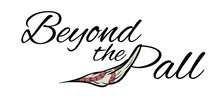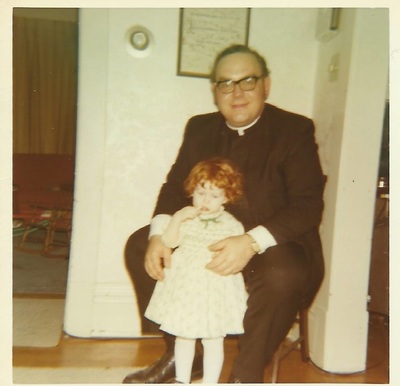|
Today is the eighth anniversary of my father's death. He was a loving husband and daddy. Dad was also a pretty good priest from what I have heard from those he pastored, I know I miss his great wit, hearty laugh and fantastic mind. Miss you, Daddy!
0 Comments
I spent a lot of time at my mother’s house in the summer of 2009. She had just been diagnosed with dementia. The memory loss was not too bad yet, so we decided that to go through some of her favourite things and label them so that the family would know their back-stories. What she and I had learned so keenly with my father’s death was that we had all kinds of questions that only he would know the answer to. We wanted to make sure that her stories were written down for the next generation. Mom’s condition continues to progress, and I am so grateful we took the time to do this little exercise.
Documentation might sound dull and to many it might be. I love documentation. I have a minor in museum studies and have worked in a halfway house where documentation was key and legally binding. I might just be one of those who really likes to document. Knowing that not all people love to document, I urge you to take the time to document key things for the family. Family History: Sit down with your older family members and listen to their stories. Perhaps if you live far away, you can Skype of call them on the phone. You can document these stories in a number of ways. You can keep a written document of their stories. You can audio record their stories. If you are really media savvy, you can incorporate old photographs and their story to create a cohesive narrative for the whole family. Maybe not all of us can trace our heritage to the Mayflower or have a president of the US in our family, but the stories of our family tells us who we come from and their stories created who we are. We can gain strength from their struggles and pass their stories on to the following generations. Photographs: Go through old photographs with people of the older generation. Today we can scan in pictures and create memory books or a database of these old photographs. Label these photographs with who is depicted and what event is taking place. So much can so easily be lost by not taking the time to find out who are in these old pictures we have stored away. Sometimes these pictures can help jar the memory of the older generation, and make it a fun way to learn family history. The Stuff of Our Lives: Maybe the things we treasure most are not things of great monetary value nor are they necessarily been in the family for generations. As I did with my mom, label the things that mean the most to you with a little story. Some things can have the story attached to them or you can make a document listing things with their story and why they are important. If you make a list, make a hard copy and send an electronic copy to your children, next of kin or someone you trust to keep the document. Include this piece of documents with the larger store of documents for your end of life plan. End of Life Documents: These are: your wills, health care proxy, power of attorney, health care documents, discharge papers, family history documents, and any plans for end of life memorials – funeral and burial plans or wishes. Tell next of kin, your children or the person who will handle all the end of life details where to find these documents. These documents should be fairly easy to find. Our loved ones might not be in the best frame of mind at the end of our lives, and it would be a great kindness to make these easily accessible and in a logical place. Today, my heart resides with the families of those whose loved ones were robbed from them in Orlando on Sunday. How can such an act happen? I have no idea. I don’t think my mind could go to a place where killing people in a crowded nightclub - a nightclub that I frequented - would ever be an option. This is not a post about the Islamic extremists, nor is it about gun control or hate crimes. This post is about how we can face our grief together. In the first place, we could start with recognizing that people are grieving. This should not be such a tricky thing since we are all made of the same stuff even with our differences. I wonder if we think that we are alike because we might feel more secure thinking that our particular group of humans is better than any other group of humans. In the face of such horror, we might be tempted to point fingers instead of reaching out in love to those in pain. This terrible act has angered so many of us. Remember to reach out a hand to those who might be suffering instead of only raging at the madness of this man’s action. We might struggle at times to recognize ourselves in the other, but in doing so we will come to a greater understanding and perhaps we can begin to heal. Take the time to recognize that while we are all going through a kind of grief, that others might be experiencing grief on a deeper level. Recognize grief for what it is. Don’t shy away from it. We have to move through this. May we move through this with understanding and love.
“Isn’t cremation green?” I hear this all the time. Cremation is not green, or not as green as a natural burial. Almost always doing something to the body after death is going to make a negative impact on the earth. Cremation is no different. Cremation might be better for the environment than having a funeral consisting of embalming, metal coffin, polyester lining, cement or metal lined vault and a large marker stone imported from China. On the other hand, cremations in North America use as much fuel as it takes to make 84 trips to the moon and back. That is a considerable amount. If you are planning cremation and you want to make sure that you are not impacting the environment too much, you need to keep in mind a few things.
Cremation does provide for less negative impact on the earth than does a full conventional burial. If you are concerned about the earth and the impact our living and dying has on the earth, please consider these things when choosing cremation. I don’t talk too much about cremation. Our society shrouds cremation in as much mystery and myth as embalming is, but that is another topic. While many people do not understand the process of cremation, it has become the most popular way North Americans deal with the body after death. Cremains are in and of themselves the final disposition of the body, and for this reason, you can do so much more with cremains for memorial purposes. Memorials can take place without a body. Funerals do not need to take place soon after death. You can be pressed into a record, shot into space, be sprinkled in the garden or be placed on the mantle in an urn. Many families make use of an urn after cremation. Remember according to federal law, urns like coffins can be purchased outside the funeral home or cemetery - one need not feel pressure to purchase from your service provider. You can decide what the urn will be or look like.
One thing to keep in mind when “preplanning” a funeral with cremation is to make sure you know what kind of urn you might be preordering. When I was a family service counselor, I worked with a few families who made a “preneed” plan for cremation. The families would bring in the plan that included a brass urn. In their heads the urn might be a beautiful Grecian-like urn, one with elegant lines. In reality the urn in the plan was this rectangular box made of thin brass. I have no idea what was really sold to these families. It could have been this very basic box. The point is that no one could ever prove one way or the other what was said initially to the family. Sometimes the product goes out of production and the cemetery or funeral home has to provide something similar to the product prepurchased. These are some aspects of the preneed sales, which do not make sense to me for the families. You could think you are purchasing one thing and in the end, your family shows up and they are given something else. It feels a little too imprecise for me. When the funeral director or the crematorium returns the cremains to the family, the cremains can be returned in a basic box. It’s usually quite functional. No one should make you feel that you need that Grecian Urn or anything else. You can hold onto the cremains until you have made a decision as to what kind of urn or to scatter the cremains. If the family has decided to go the cremation route, take your time in making the decision on what kind of urn is most appropriate. Keep in mind the standards of the cemetery you are using. They may or may not require a cremation vault. Keep in mind how you will be using the cremains. Make sure the urn is up to your standards. Consider the price point you might need to stay at. If you know someone who makes beautiful boxes or lovely ceramic urns, you can choose this. Some people divide the cremains among the family and will require several smaller containers. You and your family need to decide. You have a right to purchase anywhere you wish. You can even make your own. The choice is yours. |
Caroline Vuyadinov
Archives
December 2018
Categories
All
|











 RSS Feed
RSS Feed